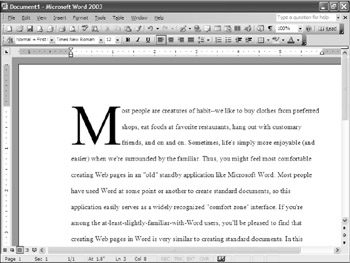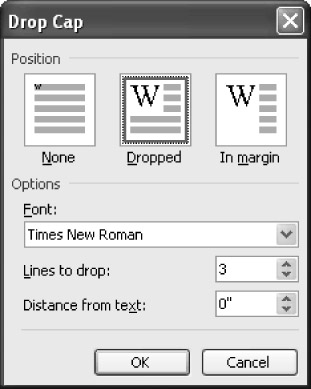Creating Drop Caps in Existing Paragraphs
|
| < Day Day Up > |
|
A popular format frequently associated with paragraphs is the drop caps. Drop caps refer to the large letters that appear at the very beginning of chapters or sections, as shown in Figure 8-12.

Figure 8-12: Drop caps are large, stylized letters that are frequently used to identify the beginning of a prominent section in a document, such as a chapter.
Word provides an easy way for you to add drop caps to paragraphs. When you use the Drop Cap feature, Word basically converts the first letter of a paragraph to a graphic. After the graphic is automatically created and situated, you can further modify the drop cap just as you modify any graphic element. To create a drop cap, follow these steps:
-
Click in the paragraph that you want to customize with a drop cap, or, if you want to enlarge more than just the first letter in the paragraph, select the letters or word(s) you want to format as drop caps.
-
Choose Format, Drop Cap. The Drop Cap dialog box appears, as shown in Figure 8-13.

Figure 8-13: The Drop Cap dialog box enables you to set parameters before the graphic for the first letter is created and inserted in your document.Cross-Reference For more information about working with graphics, see "Part 2: Reinforcing Your Message with Tables, Charts, Diagrams, and Pictures."
-
Click the Position option—None, Dropped, or In Margin—and then configure any formatting parameters you want to customize, including Font, Lines To Drop, and Distance From Text. Click OK.
If you decide not to display a drop cap in your paragraph, you can easily remove the formatting. To do so, click in the paragraph containing the drop cap, display the Drop Cap dialog box, click None, and then click OK.
Finally, note that drop caps appear above your paragraph in Normal View and Outline View. To view drop caps properly on screen, view documents that contain drop caps in Web Page Layout view, Print Layout view, or Reading Layout view.
Another common method of customizing paragraphs is to add borders around and/or shading behind selected paragraphs. To accomplish this simple feat, follow these steps:
-
Select the paragraph you want to format.
-
Choose Format, Borders And Shading.
-
Select the border or shading options you want to apply to the selected paragraph, and then click OK.
For more information about the ins and outs of creating borders and shading, see Chapter 18, "Drawing Attention to Documents by Using Borders and Shading."
|
| < Day Day Up > |
|
EAN: 2147483647
Pages: 373
- Chapter III Two Models of Online Patronage: Why Do Consumers Shop on the Internet?
- Chapter VI Web Site Quality and Usability in E-Commerce
- Chapter XIII Shopping Agent Web Sites: A Comparative Shopping Environment
- Chapter XV Customer Trust in Online Commerce
- Chapter XVIII Web Systems Design, Litigation, and Online Consumer Behavior